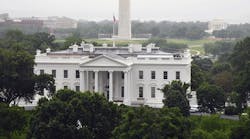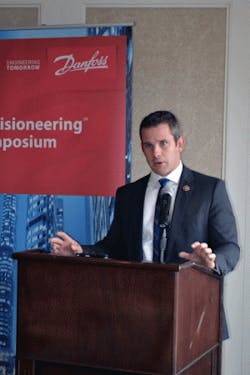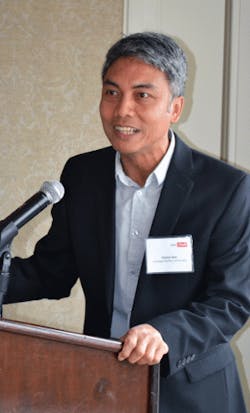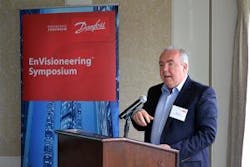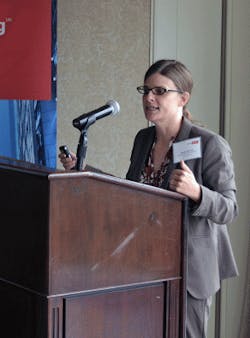The Danfoss company has been a tenacious tracker of developments and predictions related to the HVACR and energy industries, as evidenced by its ongoing EnVisioneering Symposium meetings, which recently had its 24th gathering at the Hay-Adams hotel in Washington, D.C.
The June 3 symposium waded into some complicated waters, as a 30-person panel of experts addressed connectivity, community-level regulation, integration and management, and new building-grid dynamics — all of which are realities which Danfoss believes will remake the existing build environment.
During the symposium, participants explored new opportunities in building integration strategy opened by developments in internet-building interface and sensor technology, experiments in community-scale building performance initiatives, and often-overlooked dynamics in building-grid management.
“Buildings will become smarter, and the utilities of the future will become dramatically different providers than the ones of today,” commented Lisa Tryson, director of corporate communications, Danfoss, setting the stage for the symposium. “Changes facing our industry, energy infrastructure, and commercial buildings will test our technologies, standards, and goals.”
Changes facing our industry, energy infrastructure, and commercial buildings will test our technologies, standards, and goals."
— Lisa Tryson, Danfoss
Leading off the morning was Congressman Adam Kinzinger (R-Ill.), who serves on the House Energy & Commerce Committee. Kinzinger provided an overview of challenges to a national energy strategy and an outline of one focusing on not only asset use, but also workforce development and regulatory frameworks.
“A national agenda doesn’t need to be energy source specific,” Kinzinger said. “We instead need to focus on a few things: workforce development to ensure properly trained and educated workers are available for the high-tech jobs in the clean energy industry and the infrastructure of the energy industry — whether it be demand response technology or physical transmission assets. The regulatory environment that prevents new technologies also needs to be streamlined. Energy efficiency is great because it’s often a simple and affordable way to help meet the energy demands of our nation."
Kinzinger said U.S. manufacturing needs safe, reliable affordable energy, but that price swings can impact the workforce. He cited a study that showed improvements in natural gas production could create 300,000 jobs. And, to the surprise of some and possible dismay of others, Kinzinger also said that along with wind and solar power generation, it would be a mistake to ignore the future contributions nuclear power can bring to the energy debate, and development of cleaner power.
Kinzinger added that the national debt is a major hurdle in furthering the development of the United States' energy infrastructure.
"What can the federal government do, while it pays $250 billion in 2015 interest on the national debt? The faster we can bring down the debt, the better. Government must be a partner with the private sector, to bring us to a goal of energy security," he said. "For a solid energy infrastructure, we need to ensure that our assets are used most effectively and efficiently. We must strengthen the economy, to benefit businesses and families."
Kinzinger named workforce development, energy diplomacy, and bipartisan energy efficiency legislation as keys to further U.S. energy progress.
Integrating Technologies & Changing Behavior
Turning to developments in research and the commercialization of new technology, Azizan Aziz, assistant research professor at the Center for Building Performance and Diagnostics at Carnegie Mellon University, and Mike Schell, vice president of marketing and business development at AirTest Technologies Inc., outlined new possibilities in remote building management and increasing occupant control which drive higher building energy performance.
According to Aziz, returning building control to occupants while advancing energy performance is possible through the development of building designs where data, intervention, and occupant education and behavior change are considered.
"The Internet of Things" will empower building occupants for better health, productivity and energy savings," he said.
Schell specifically looked at how the shift to wireless technology can open new possibilities for low-cost installations and at how sensors and connectivity put high-performance/high-comfort buildings within reach. He suggested that the building of the future – considering only 1% of the total building market is new construction — will be the buildings of today, but that working with these existing buildings will require industry to face some of the deeper challenges including the proliferation of moisture and mold problems, building temperature control that no longer controls moisture, and the cost of technology.
“Changing technology is easier than changing a paradigm,” Schell said. Similarly, building labeling, participants discussed, could be a driver of energy efficiency deployment.
"The existing building market makes up 99% of our buildings. Those are the ones that have to be fixed. The challenge is how to deal with those buildings," he said, and added that a major improvement lies in expanding the wireless capabilities of existing buildings.
"WiFi is widespread and dependable. Network hardware is low cost and available anywhere, and it's widely understood how to set up and troubleshoot networks." Shell said.
Tracking Performance & the Grid-Utility Relationship
In addition to building labelling, the symposium addressed the macro performance levels that are put within reach when building design and management is moved to the community level – either the city level, as discussed by Marshall Duer-Balkind, program analyst at the District Department of the Environment, Government of the District of Columbia, and at the campus level, as showcased by Thomas Nyquist, executive director, engineering and campus energy, at Princeton University.
In the District of Columbia, government has taken an active role to make the city green and liveable. By 2032, the city has a target of reducing energy use and greenhouse gas emissions by 50%, and increasing the use of renewable power to 50% of the total source. Today, Duer-Balkind explained, D.C. is first in the nation among large cities in LEED- and ENERGY STAR-certified square footage per capita, first in the nation among total ENERGY STAR buildings and the number of LEED projects, first in solar energy per capita among states, and first in green power purchasing for the past five years.
For D.C., the strategy to improve energy efficiency and sustainability relies on benchmarking, reporting, and labeling buildings. “By collecting this data and making it public to the market, we can drive energy efficiency as people compare building performance and make selections when they want to go lease an apartment, buy a condo, lease office space – make selections for buildings that are more energy efficient. And we’re already seeing this happen.”
At the campus level, Princeton University has set a target of reducing its energy use by 1/3 and reducing CO2 emissions to 1990 levels by 2020. Reaching this level of sustainable energy use depends on the use of a distributed generation microgrid system that includes cogeneration, chilled water and thermal storage systems, solar photovoltaic electricity production, and biodiesel fuel oil. According to Nyquist, Princeton also relies on the tracking of demand on the local utility in order to be able to adjust and reduce capacity costs, which has saved the university approximately $1.6 million annually.
Dr. Shelley Norman, a regulatory economist in the Electricity Division of the Maryland Public Service Commission, outlined a central challenge of the building performance-grid equation. She outlined how increased amounts of distributed generation with and without grid reliance would affect traditional and alternate ratemaking approaches. Dr. Norman also highlighted the concerns that arise when regulators work to fulfill the regulatory compact between electricity users, generators, and distributors as technology evolves. While distributed generation, she explained, can have significant benefits for the grid and society – including reliability/resilience, cleaner power, load shaping, and congestion drops, it can impose costs depending on where it is installed and how it functions within the grid. Distributed generation also raises the risk of stranded investments shifting even unchanged costs to those unable or unwilling to participate, Dr. Norman explained. Developing a regulatory framework for sustainable funding is critical moving forward.
The 24th EnVisioneering Symposium made clear that buildings of the future and the industries that deliver them will be very different than today. Forces already in motion are driving profound change. Industry watchers know that big change means big challenges. Participant discussions seemed to agree that it also means big options and big decisions lie ahead – and perhaps not as far ahead as was once thought.
Edited by Terry McIver, with some information added.








